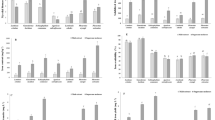Abstract
TRANSLOCATION of nutrients by fungal mycelium has been reported by Schütte1 and by Grossbard and Stranks2. Attempts in this Department to determine the rate of transport of phosphorus using a tracer technique have, however, indicated that the mycelium of Phycomyces nitens, Absidia glauca and Chaetomiums pp. is only able to transport phosphorus-32 under certain limited conditions.
This is a preview of subscription content, access via your institution
Access options
Subscribe to this journal
Receive 51 print issues and online access
$199.00 per year
only $3.90 per issue
Buy this article
- Purchase on Springer Link
- Instant access to full article PDF
Prices may be subject to local taxes which are calculated during checkout
Similar content being viewed by others
References
Schütte, K. H., New Phytol., 55, 164 (1956).
Grossbard, Erna, and Stranks, D. R., Nature, 184, 310 (1959).
Author information
Authors and Affiliations
Rights and permissions
About this article
Cite this article
LUCAS, R. Transport of Phosphorus by Fungal Mycelium. Nature 188, 763–764 (1960). https://doi.org/10.1038/188763a0
Issue Date:
DOI: https://doi.org/10.1038/188763a0
This article is cited by
-
Translocation in fungi
The Botanical Review (1968)
-
Transport of Carbon in Fungal Mycelium
Nature (1961)
-
Microscopic Morphology of Trichophyton Rubrum11From the Department of Dermatology, University of Miami Medical School, Miami, Florida.Presented at the Twenty-second Annual Meeting of The Society for Investigative Dermatology, Inc., New York, N.Y., June 29, 1961.This study was supported in part by U. S. Army Contract No. DA-49-007-MD-731 and from National Institutes of Health Grants.
Journal of Investigative Dermatology (1961)
Comments
By submitting a comment you agree to abide by our Terms and Community Guidelines. If you find something abusive or that does not comply with our terms or guidelines please flag it as inappropriate.



